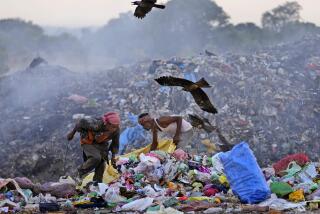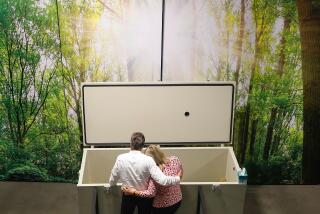A final rite’s toll on the living
- Share via
VARANASI, INDIA — Cremation fires crackle all day long on the chipped concrete steps of this riverside holy city, the blazes spewing ash and flakes over the mourners who crowd its famous piers. Sweating, bare-chested men stoke the funeral pyres, squinting against the sting of smoke as they lug and stack the bundles of logs needed to burn the procession of Hindu dead.
And when the bodies are incinerated and the families have taken away the ashes of their loved ones, the men sweep the residue into the Ganges River.
The detritus of death, mingling with life.
Devout Hindus regard cremation as an essential rite that frees the soul from the body, enabling its journey to the next level. But with India’s Hindu population of about 800 million ensuring a massive number of open-air cremations, there is a growing awareness that this adherence to religious orthodoxy carries a toll for the temporal world.
It takes a lot of wood to burn a body: The demand for funeral pyres strips the country of more than 50 million trees annually, according to some estimates. Cremations also release carbon dioxide into the atmosphere. And the body parts sometimes dumped into rivers and streams add further toxicity to water that is already badly polluted.
“We have come to a stage where if we don’t come up with a solution for dealing with the dead, we are going to affect the survival of the living,” said Anshul Garg, director of Mokshda, a nonprofit group in New Delhi that is campaigning for an environmentally friendly approach to cremation.
In traditional Hindu cremations, the body is placed atop a pile of wood. The corpse is then covered with more wood and burned in the open air. Mokshda says this method requires as much as 880 pounds of wood to burn a single corpse (though the wood porters in Varanasi say the amount is closer to 600 pounds), a process that can take as long as six hours.
Mokshda’s alternative is the “Green Cremation System,” a cremation bier it developed 15 years ago and has been tinkering with since. The organization believes it has perfected its design, saying it can burn a body using a mere 220 pounds of wood in a third of the time.
Wood is integral to Hindu cremation rites, a symbolic connection between the body and the earth, which is why the first layer of wood is laid on the ground. The Mokshda system’s innovation is to place that first layer of wood on a raised metal grate, allowing for better air circulation. A chimney is placed over the pyre to cut heat loss.
“We have improved the flow of air and where there is a proper flow of air, your combustion efficiency increases,” Garg said. “This is not a new technological gizmo. It’s a simplicity, like improving the efficiency of a wood stove.”
Mokshda’s system has made only tiny inroads so far. It has 12 units of its latest model, which on average costs about $30,000, in operation, with orders for 80 more in the pipeline. But the potential demand is enormous. Mokshda says it has identified 800 crematoriums across India as possible users. The Delhi metropolitan area alone has about 350 crematoriums, their flaky residue occasionally drifting over nearby neighborhoods.
But the Mokshda system faces two big obstacles to acceptance. For one thing, improving cremation methods is a low priority for cash-strapped municipalities facing a host of public health issues. An even greater obstacle is the resistance of traditionalists who don’t want to mess with a matter as sensitive as the fate of a loved one’s soul.
“We have changed other rituals -- marriage, eating habits, clothing -- but rituals around death are the hardest to change,” Garg said. “People are hesitant to talk about death; there is a fear. So they say they’ll stick with what they’ve been following through the ages.”
The government also has largely failed to get Hindus to sign on to environmentally friendly cremations. Beginning in the 1960s, municipal governments began installing electric or gas-fueled crematoriums, offering to dispose of bodies at a fraction of the cost of traditional cremations, which can be $50 to $75, depending on the quality and amount of wood used.
But most Hindus have balked at this option, saying that oven-like crematoriums prevent them from carrying out important rituals such as the mukhagni, in which a fire is lighted in the body’s mouth, and the kapal kriya, in which the corpse’s skull is shattered by a blow from a bamboo stick to release the soul.
It is mostly unclaimed corpses that are burned in electric and gas crematoriums, stigmatizing them as being for the poorest of the poor. “It’s a good method -- there’s less pollution because you are not dumping lumps of flesh into the river -- but we don’t get many bodies,” said Panchdev Singh, 47, the operator of Varanasi’s electric crematorium. There are no bodies awaiting Singh’s attention. One of his two machines is out of order, and business has fallen off since 2000, when the municipality raised the price to about $12.
“Now the only people who come here are the very poor or the ones brought in by the police,” Singh said.
Mokshda says its system can succeed where the electric one failed because it allows Hindus to perform traditional rituals. The challenge is to convince devout Hindus that using less wood does not break with orthodoxy. Even Garg acknowledges that it will be a while before Mokshda’s cremation bier is welcome in a place such as Varanasi.
“I doubt it would be a hit here,” said Dinesh Yadav, 21, who has taken over the family wood business, running a gang of 10 porters for cremations on Varanasi’s ghats, or riverside steps. “People want to do it the Hindu way. Older people, especially, will never settle for being burned with less than the required quantity of wood.”
Yet the realities of the outside world intrude even on this holiest of Hindu cities. Yadav recalled the wood shortage of 2005, when scarcity meant the bodies backed up on the ghats while they waited for supplies. The price of wood is 50% higher than it was five years ago.
“A time will come when we’ll probably have to move to a new way,” he said.
And in his office on Varanasi’s back streets, Kameshwar Upadhyay, a Hindu scholar known for his strict views, looked thoughtfully at photographs of the Mokshda system and didn’t dismiss it as heretical. He acknowledged that India is groaning under the stress of an expanding population. And if he was not about to welcome the Mokshda system in the spiritual center of Varanasi, he thought it might not be a bad idea in big cities.
“There is a provision that after death, a person needs to be completely de-linked from this Earth, and fire helps in that goal,” Upadhyay said. “But there are changing situations that come to us on Earth and we have to work out compromises for that. As long as mukhagni and kapal kriya can be followed, there should be no problem.
“Fire,” he said, “is fire.”
--
More to Read
Sign up for Essential California
The most important California stories and recommendations in your inbox every morning.
You may occasionally receive promotional content from the Los Angeles Times.










